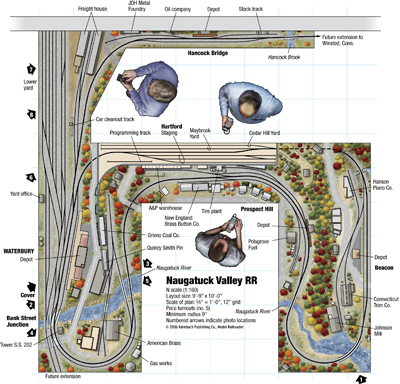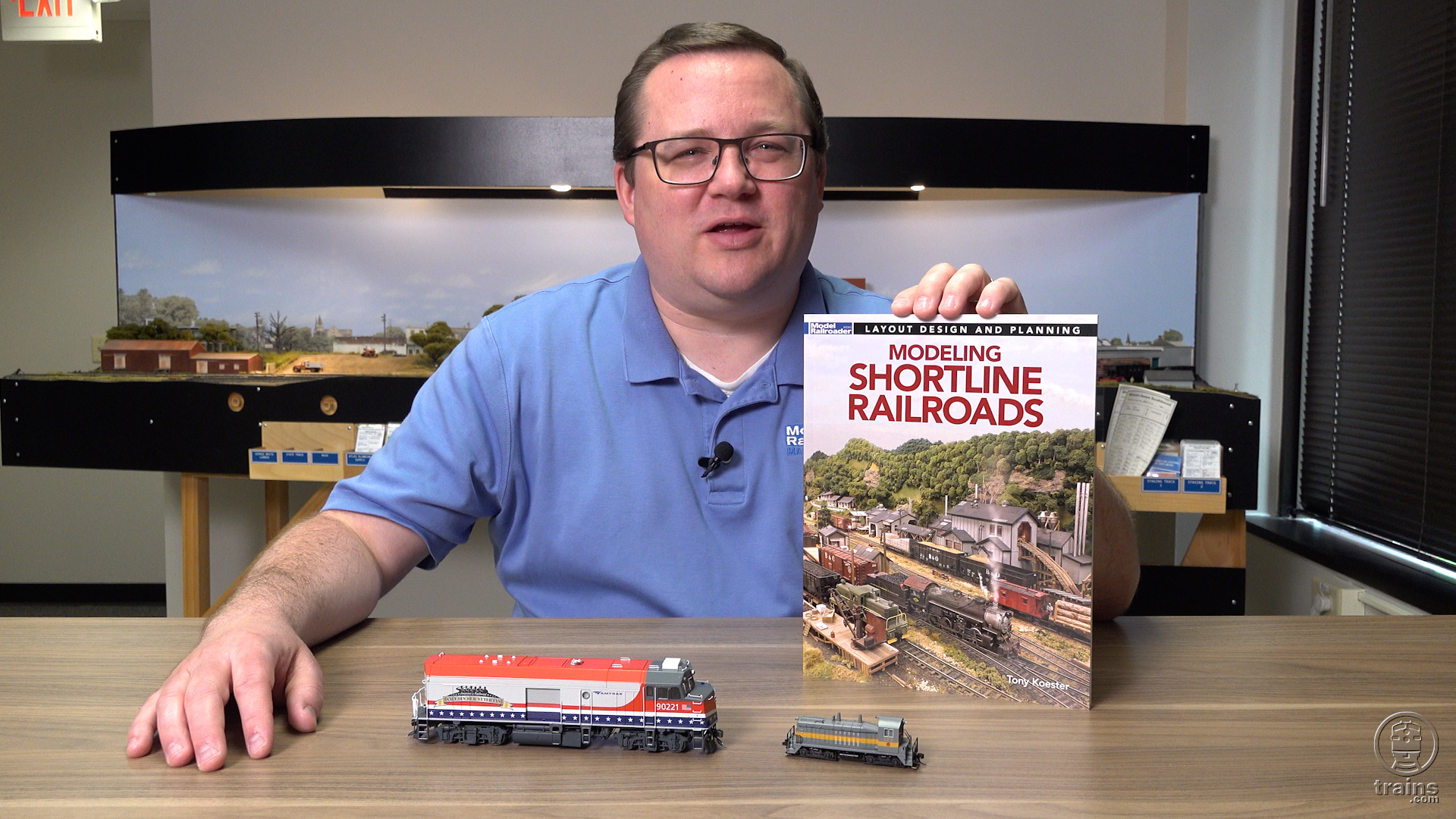Name: Naugatuck Valley RR
Scale: N (1:160)
Size: 9’9″ x 10’0″
Prototype: New York, New Haven & Hartford RR
Period: fall 1959
Style: walkaround
Mainline run: Waterbury/south 41 feet, Waterbury/north 11 feet
Minimum turnout: no. 5
Minimum radius: 11″
Originally appeared in the April 2006 issue of Model Railroader.
Click on the link to download a PDF of this track plan















This layout and the May 2011 article "Practical Tips for Switching Fun" are what I based my current layout on. I'm taking alot of liberties with the Camden and Amboy Railroad, just to work the switching in. I don't know how many times I've gone back to check out the concepts. Seeing it "live" on the video is great. Only complaint is that the video is too short.
Nice work.
Lived in Naugatuck and even worked in the Waterbury Station (long the home of the Waterbury Republican newspaper, now that the passenger trains are gone) and was TOO STUPID to do this article myself!
Some additional observations: Prospect Hill is not really on the RR right of way and would be quite a mountain for a train actually to go over. The actual line runs south from Waterbury, around the hill, along the Naugatuck River through Naugatuck (the next town), where there was a tire plant and I believe still is a chemical plant (originally Naugatuck Chemical and eventually Uniroyal) served by tank cars. The tire plant reclaimed old tires rather than made new ones, and I'll never forget the day my father came home after one of the maintenance employees accidentally had been half shredded instead of a tire. It was my dad's worst day ever on the job.
The next town south was Beacon Falls (not Beacon), which had a large warehouse downtown, a hinge-manufacturing facility I once worked for (Homer D. Bronson Co.) and contributed more than its share of aggregates to Connecticut construction projects. One of these aggregates is known as trap rock, which makes pretty good RR ballast. Indeed, one of the local clubs got its model ballast from the New Haven Trap Rock Company by visiting the company's plant and running off with screened shards from the blasting. They always received the finest compliments for their model ballast — not surprising since it really was ballast!
(Warning: The shards are razor sharp, so one must be careful handing them, in the event anyone is thinking of duplicating the effort.)
Waterbury was the home of the brass industry for many, many years. This was because the brass workers had lived there for generations, ever since they had been smuggled up the river from Bridgeport in wooden barrels to keep them from being discovered by the British (problems with illegal aliens are not new in this country). Waterbury also had some ammunition factories during the world war, undoubtedly served by the railroad since I know the assembly buildings were near the tracks. The buildings were half sunk in the ground, and the roofs were similar to model removable roofs so that, in the event of explosion, the blast would be channeled upward instead of outward. The ammo plants were there because the brass plants nearby — American, Century, and a tube manufacturer whose name slips my mind — made the brass cartridge casings.
South of Beacon Falls is Seymour, and south of that Derby and Ansonia (which had chemical plants). Bridgeport was the end of the branch, an electrified portion of the New Haven, since trains from New Haven ran through there to Grand Central Station and its underground facilities (which prohibit steam or diesel operation for all the fumes).
The Waterbury depot/newspaper office at 389 Meadow is two floors with a titanic clock tower that really dominates the skyline. The corporate offices of American Brass also would be worthy of modeling in a city scene.
In Naugatuck, the depot also was taken over by a newspaper, the since defunct Naugy News, which used most of the building but still left enough for the local RDC and a passenger local to frequent. At the south end of town was Peter Paul candy (makers of Mounds and Almond Joy), but it was served by truck, not the railroad, for being on the wrtong side of the Naugatuck River.
The E-W line to Hartford and New York State was gone by the time I got there, but I recall local freights did push further north. The Seth Thomas Clock Co., some garment warehouses, and a large electro-plating operation might have been served by these on their way to Winsted.
Connecticut in the fall generates fiery leaf falls (the soil in the area is particularly conducive to displays of violent color among the oaks, maples, and ash). An even more spectacular event occurs rarely, when conditions create monster ice storms which coat everything in crystal. On those rare mornings, Route 68 up Prospect Hill from the south (to the east of the actual railroad) probably offered one of the most spectacular displays in nature, like looking at a world made of nothing but glass for as far as the eye could see. But, this played havoc with the trees and the electrical lines — the trees could not take the weight, and when the branches would come down, they'd take the power lines with them. Then we'd all stumble around in the dark.
1959 is a great era to model i like the Fall timeframe
great lay out, wish i had more room. Im on the hunt for a 4×8 plan now due to space i havnt got much lol
Very nice track plan with numerous operational opportunities. I'm in the planning stages of my layout using templates and this plan will fit nicely into my space and I love the hidden staging.
LIke this layout plenty of yard space period is in my leauge would like to build this in same era maybe at the diesel transition and themed in pennsy
It gave me some great ideas to incorporate into my layout!
I really enjoyed the article on prototypical switching practices based on The Naugatuck Valley RR in a recent issue of Model Railroader. I will be incorporating most of these practices on my Kaw Valley Lines RR. This article cleared up some problem spots for me, thank you for sharing!
Very nice lay out, I just down sized our home and now in 2 BR. condo but have enough space for a 4×8 lay out if any one has an ideas I am at grd069@shaw.ca in Kelowna B.C. Canada
I kept the Chicago and Alton / The C-O Alleganey loco only and the challenger loco.all in D.C. too old for D.C.C so any ideas are welcome
Greetings from Canada
love it , I am going to try something like this myself
Wow will perhaps use some of it.
A great layout with plenty of operational opportunitys & its addaptabilty to turn it into a exihbition layout, keep up the good work .
From Down under Pete
Great for a HO scale
SWEET
very usefull for all that are builting a layout no matter what size.